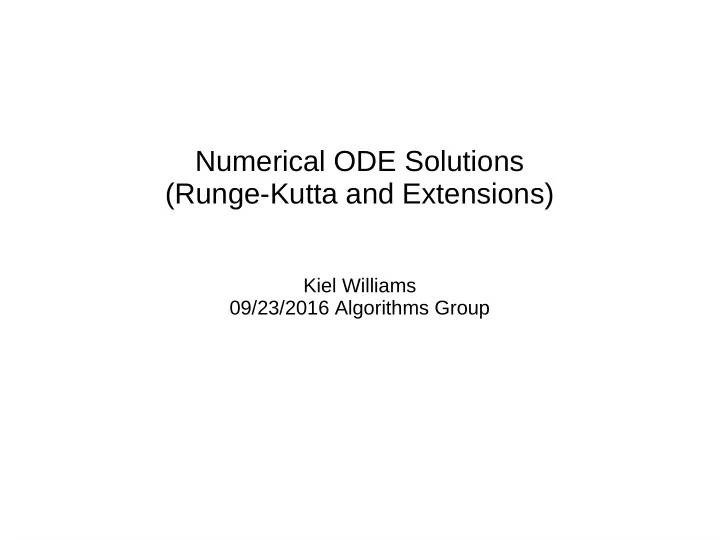

Numerical ODE Solutions (Runge-Kutta and Extensions) Kiel Williams 09/23/2016 Algorithms Group
Form of the Problem Need to solve: Other initial condition types exist for higher-order equations (boundary-values) Accurate ODE solutions essential to countless theoretical problems Many, many, many different approaches for doing this. We'll review some of the most common and straightforward
Simplest Guess: Euler Approach Simplest guess for discretizing solution: But method works poorly: How can we do better in controlled way? − Runge-Kutta family of techniques
Going Beyond: Runge-Kutta Runge-Kutta methods all take form: Described pictorially by Butcher tables: For the Euler method:
4th-Order Runge-Kutta The Runge-Kutta method typically refers to 4th-order Runge-Kutta: In Butcher form:
4th-Order Runge-Kutta The Runge-Kutta method typically refers to 4th-order Runge-Kutta: In Butcher form:
Runge-Kutta Examples and Contrast RK4 does well, even for large step-sizes − RK4 error of ~0.0001, compared to ~0.1 for Euler RK4 error scales as O( h 5 ) If y' depends strictly on x, RK4 is equivalent to Simpson's Rule integration
Runge-Kutta Alternatives: Multi-Step Methods Runge-Kutta isn't the only feasible option − Instead of expanding the Butcher table, evaluate the derivative at more places 2-Step Adams-Bashforth is one of the simplest useful methods: Like Euler's method, but weights first-derivative value at different places Coefficient determined by Lagrange polynomial interpolation formula
Runge-Kutta Alternatives: Multi-Step Methods Adams-Bashforth substantially beats Euler − A-B error of ~0.01, compared to ~0.1 for Euler Adams-Bashforth error scales as O( h 3 ) One drawback: need 2 points to start the chain − Need one Euler or RK4 step to initiate
Implicit Methods for ODE's All methods shown so far are explicit methods, with recursion relations of form: Implicit methods involve recursions relations of the form: Offer improved accuracy, but need to solve an equation to get y n+1 , evaluate right-hand side of equation Typical ways to do this: fixed-point iteration, Newton's method
Implicit Methods for ODE's, Backward-Euler Backward's Euler is simplest implicit method: (Forward Euler, Explicit) (Backward Euler, Implicit) To extract value of y n+1 needed to evaluate right-hand side, use fixed-point iteration to achieve self-consistency:
Implicit Methods for ODE's, Backward-Euler In this example, backward-Euler doesn't do much better than basic Euler – Not always true! Error-scaling is the same as Euler Added complication: need input tolerance for self-consistency loop Best to have − tolerance as function of h
Implicit Multi-Step: Adams-Moulton Adams-Moulton methods family combine Adams-Bashforth multi-step approach with implicit techniques Most-obvious non-trivial example is ODE analog to the trapezoid rule: Arbitrarily high-order algorithms generated very similarly to higher-order Adams-Bashforth approach
Implicit Multi-Step: Adams-Moulton Trapezoid much better Euler, competitive with RK4 − Much simpler algorithm than RK4! Error scaling goes as O( h 4 ) – compare to O( h 3 ) for 2-step Adams-Bashforth
Exponential Integrators Equations whose solutions contain e ax terms notoriously hard to handle – exp. integrators consider ODE's of form: We can discretize the exact formal solution to this equation: Allows exponential part of y' to be handled exactly – can treat the “rest” of y' as a perturbative expansion
Exponential Integrators Exponential methods exactly solve y = y' – Even “good” explicit methods accumulate large errors Big drawback: one must often approximate to get ODE in proper form to implement
Summary Euler method is poor, motivates superior techniques: − Explicit methods solve ODE by extrapolating from values of y, y' at previous points − Examples include all Runge-Kutta type methods, including RK4, multi-step methods like Adams- Bashforth Implicit methods require knowledge of function value at next point: − Require solving an equation, but give better scaling for same # of function evaluations − Often preferred in solution of “stiff” ODE's.
Recommend
More recommend